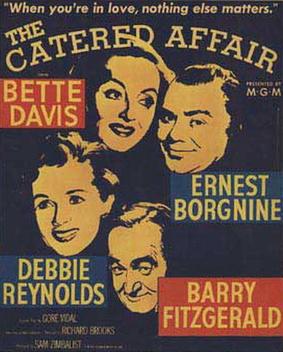
An overlooked example of mid-20th-century social realism, The Catered Affair (dir. Richard Brooks, 1956) has quite the kitchen-sink pedigree. The film is adapted from a teleplay by Paddy Chayefsky and features Ernest Borgnine in a leading role, both of whom had just won Academy Awards for their work on the working class love story Marty (dir. Delbert Mann, 1955). On the more sensational end, director Richard Brooks had come to prominence for writing and directing Blackboard Jungle(1955), the seminal film about conflicts at an inner-city school.
The Catered Affair marries those two strains of realism, pairing family drama with energetic blocking and dialogue, and the result is a touching, if somewhat clumsy, depiction of life. At the movie’s center is Aggie Hurley (played by Bette Davis), a middle-aged housewife in The Bronx whose husband, Tom (Borgnine), is a cab driver who’s been saving money for years to purchase his own taxi medallion. Their daughter Jane (Debbie Reynolds) has just announced her marriage to her longtime boyfriend Ralph (Rod Taylor). The young couple would like to have a small, quick wedding so they can fit their honeymoon into Ralph’s teaching schedule, but Aggie would prefer that her daughter have the big fancy reception “with all the trimmings” that Aggie never got to have. Money is tight, though, and the process of planning the wedding brings on more conflict than anyone involved had bargained for.
In a brilliant bit of casting, the filmmakers decide to place glamour icon Bette Davis at the heart of action. There’s a productive irony in seeing Davis in the role of a woman who yearns both for the finery that’s beyond her social class and for the passionate love that her marriage to Tom denies her. Not only does the casting of Davis highlight the tragedy in Aggie’s character, but also it sells the audience on the hope that, just maybe, the Hurleys will be able to pull this affair off. If Bette Davis isn’t capable of giving her daughter a ritzy blowout, well, then who exactly is?
It’s Debbie Reynolds, however, who is the real revelation of the film. Primarily known for her roles in comedic films such as Singin’ in the Rain (dir. Gene Kelly and Stanley Donen, 1952)—or, if you’re my age, as the grandmother in the Halloweentown TV movies—Reynolds shows a startling amount of dramatic range throughout the film. She’s still got that light charm about her, especially when Jane and Aggie are out dress shopping. But her facial expressions during tense family moments help sell the scenes; like the audience, she is so often caught between concern for and exasperation with everyone else on screen. And the one time she let’s her temper flare, when she decides to just call the whole shebang off, is the single most cathartic moment in the film.
The film is strongest in its first act, which counterintuitively is also the least filmic portion of the movie. There’s a real sense of commotion when Jane announces her wedding plans, not because it’s earth-shattering news, but because life in a cramped, lower middle class apartment is naturally chaotic. Characters are constantly entering and exiting the scene like they’re walking on and off stage, which means that everyone has to keep restarting their conversations to catch the newcomers up. The use of static long takes is similarly more theatrical than filmic, but those shots serve to underscore just how little breathing room is to be found in the apartment.
Unfortunately, The Catered Affair suffers from some structural problems which blunt its emotional impact. Most notable among these issues is the role of Aggie’s brother Jack (Barry Fitzgerald). Uncle Jack primarily functions as a source of conflict for the rest of the family: he’s hurt about not being invited to Jane’s original wedding ceremonies, so he’s one of the motivations for having a big affair in the first place. But he also has a subplot involving his lady friend (Dorothy Stickney) that in theory should flesh out his character, but it’s so thin that it merely pads out the run time.
Further, the editing is less than inspired, and in some places actively detracts from the picture. Scenes will sometimes cut between two differently lit shots, briefly making it difficult to track the geography of the image. The use of transition effects is uniquely at odds with the staid realism of the rest of the picture; I suspect that fading to and from black, or even straight cuts, would have served the project better. There’s also a glaring continuity error during the dinner with Ralph’s parents, where Ralph teleports to the opposite side of the table. Normally, such a slip would be inconsequential, but the filmmakers repeatedly frame him and Jane tightly together while their respective families flaunt their wedding gift ideas. Their unified powerlessness to direct their own wedding is central to the scene, so to break that visual image is uncharacteristically sloppy.
Despite that, on the whole I’d say that The Catered Affair has a great eye for detail. I love, for example, how the light bulb hanging in the Hurley’s kitchen flickers when someone shuts the door to the ice box, or how a fellow tenant just happens to be carrying groceries upstairs when the Hurleys are about to start arguing. And I appreciate how, when the family is looking for a banquet hall to rent, the filmmakers decide to have someone sweeping up paper streamers from a previous engagement. The film’s world feels lived in, and if there’s one sense any kitchen sink drama must achieve, it’s that. For all the film’s faults, I’ve seen seen few classic Hollywood pictures that manage to capture daily life so effortlessly.